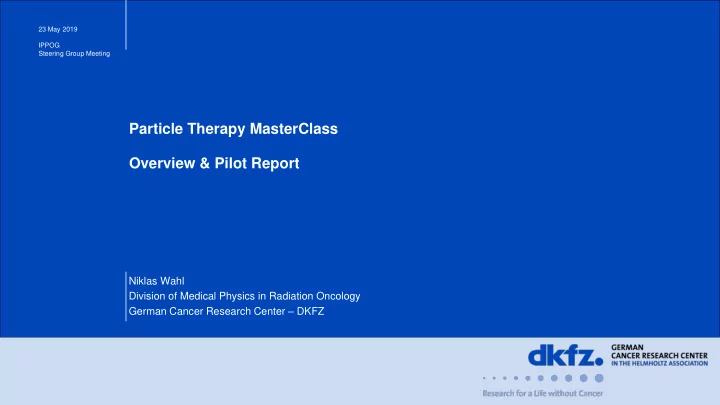

23 May 2019 IPPOG Steering Group Meeting Particle Therapy MasterClass Overview & Pilot Report Niklas Wahl Division of Medical Physics in Radiation Oncology German Cancer Research Center – DKFZ
Author Division MasterClass on Particle Therapy – Why? 8/15/2019 | Page2 • Show students that particle physics is not only fundamental research, but can also be applied fundamental research spawns “real life” applications • Particle therapy has left the experimental stage and is clinically established • The nature of cancer is often not well explained / understood at school level • Cancer is a widespread disease (2012: 14e6 new cases, 50% mortality 10y) almost everybody will be somehow affected (family, friends, etc.) 8/15/2019 | Slide 2 | Niklas Wahl | n.wahl@dkfz.de | Particle Therapy MasterClass: Overview & Pilot Report
Author Division Pilot MasterClass on Particle Therapy at DKFZ, April 5 th – Schedule 8/15/2019 | Page3 Participants: 17 students (age 16-18) from the Heidelberger Life Science Lab • 9:15 – 11:30: Lectures on physics background & treatment planning • 11:30 – 12:15: Lunch • 12:30 – 13:30: Visit (in Heidelberg: HIT) • 14:00 – 16:00: Hands-on Particle Treatment Planning • 16:00 – 16:30: Internal discussion of results • 16:30 – 17:00: Video conference (with GSI & CERN) 8/15/2019 | Slide 3 | Niklas Wahl | n.wahl@dkfz.de | Particle Therapy MasterClass: Overview & Pilot Report
Author Division Introductory Lectures 8/15/2019 | Page4 1 st lecture – From particle physics to radiation dose • What is cancer? How can we treat it? Why radiation therapy? • What is radiation dose? Interactions of particles with matter different types of radiation (photons vs. charged particles) • How do we produce radiation dose clinically? accelerators (LINACs, synchrotrons, cyclotrons?) Depth in the body (mm) 8/15/2019 | Slide 4 | Niklas Wahl | n.wahl@dkfz.de | Particle Therapy MasterClass: Overview & Pilot Report
Author Division Introductory Lectures 8/15/2019 | Page5 2 nd lecture – Treatment Planning • How do we see inside the body? Imaging (CT) • How do we find the tumor? Segmentation 𝐹 = 64.44 𝑁𝑓𝑊 𝐹 = 116.53 𝑁𝑓𝑊 𝐹 = 95.26 𝑁𝑓𝑊 • How do we plan the treatment? • How do we calculate dose? • How do we optimize dose? • How do we evaluate the treatment plan? 8/15/2019 | Slide 5 | Niklas Wahl | n.wahl@dkfz.de | Particle Therapy MasterClass: Overview & Pilot Report
Author Division Visit – Heidelberg Ion Therapy Center (HIT) 8/15/2019 | Page6 Beam transport line Ion Quality Synchrotron source control LINAC Gantry Treatment rooms Siemens Medical First carbon ion facility with 360 degree gantry (First patients in 2009) 8/15/2019 | Slide 6 | Niklas Wahl | n.wahl@dkfz.de | Particle Therapy MasterClass: Overview & Pilot Report
Author Division Measurement: Hands-On Treatment Planning 8/15/2019 | Page7 • Based on our Matlab open source toolkit simplified MasterClass version compiled as standalone software 1. Treatment planning with photons 2. Treatment planning with protons & carbon ions show advantage of particle treatment plans 3. Difficulties of particle therapy planning • biological treatment planning • impact of uncertainties 8/15/2019 | Slide 7 | Niklas Wahl | n.wahl@dkfz.de | Particle Therapy MasterClass: Overview & Pilot Report
Author Division - an open-source toolkit for 8/15/2019 | Page9 dose calculation and optimization • 3D dose calculation Photons: Singular value decomposed pencil beam algorithm Protons: Pencil beam algorithm Carbon ions: Pencil beam algorithm & RBE computation • Dose optimization Photons: Physical dose optimization Protons: Fixed RBE (1.1) dose optimization Carbon ions: Variable RBE dose optimization • GUI for visualization and analysis and standalone • Base data Example patient data (CORT data set) & DICOM Import www.matrad.org Physical & biological base data for a photon LINAC, a proton machine, and a carbon ion machine 8/15/2019 | Slide 9 | Niklas Wahl | n.wahl@dkfz.de | Particle Therapy MasterClass: Overview & Pilot Report
Author Division Acknowledgements 8/15/2019 | Page11 Alumni Development team @ dkfz Mark Bangert Niklas Wahl Hans-Peter Wieser Lucas Burigo Eduardo Cisternas Oliver Jäkel Cindy Herman Oliver Schrenk Thomas Klinge Ahmad Neishabouri Verena Böswald Amit Ben Antony Bennan Henning Mescher Noa Homolka Alexander Stadler Paul Meder Guiseppe Pezzano Lucas-Raphael Müller Hubert Gabrys HIT cooperation Silke Ulrich Benjamin Ackermann Swantje Ecker Advisors Malte Ellerbrock BA 2279/3-1 Martin Siggel Andrea Mairani Peter Ziegenhein Katia Parodi Thomas Tessonnier 8/15/2019 | Slide 11 | Niklas Wahl | n.wahl@dkfz.de | Particle Therapy MasterClass: Overview & Pilot Report
Author Division Particle Therapy MasterClass – Survey Results 8/15/2019 | Page12 • How much did you enjoy the masterclass? (1 to 5): Average: 4.8 ± 0.4 • How easy or difficult was the masterclass? (1 to 5): Average: 2.6 ± 0.5 • Favorite parts: 1. Tour 2. Hands-On Treatment Planning with matRad 3. Introductory Lectures 8/15/2019 | Slide 12 | Niklas Wahl | n.wahl@dkfz.de | Particle Therapy MasterClass: Overview & Pilot Report
Recommend
More recommend